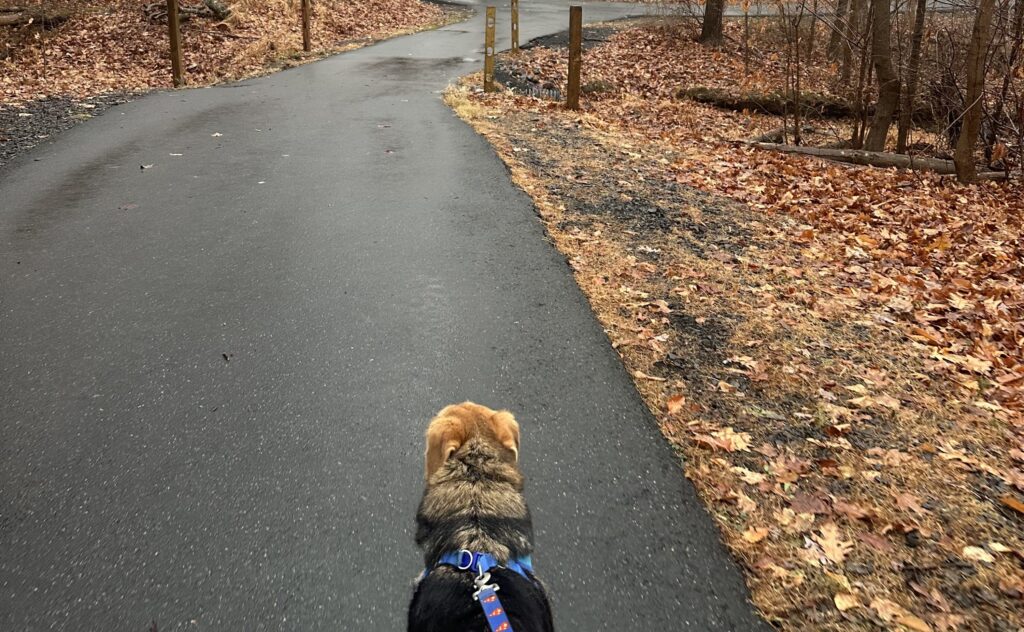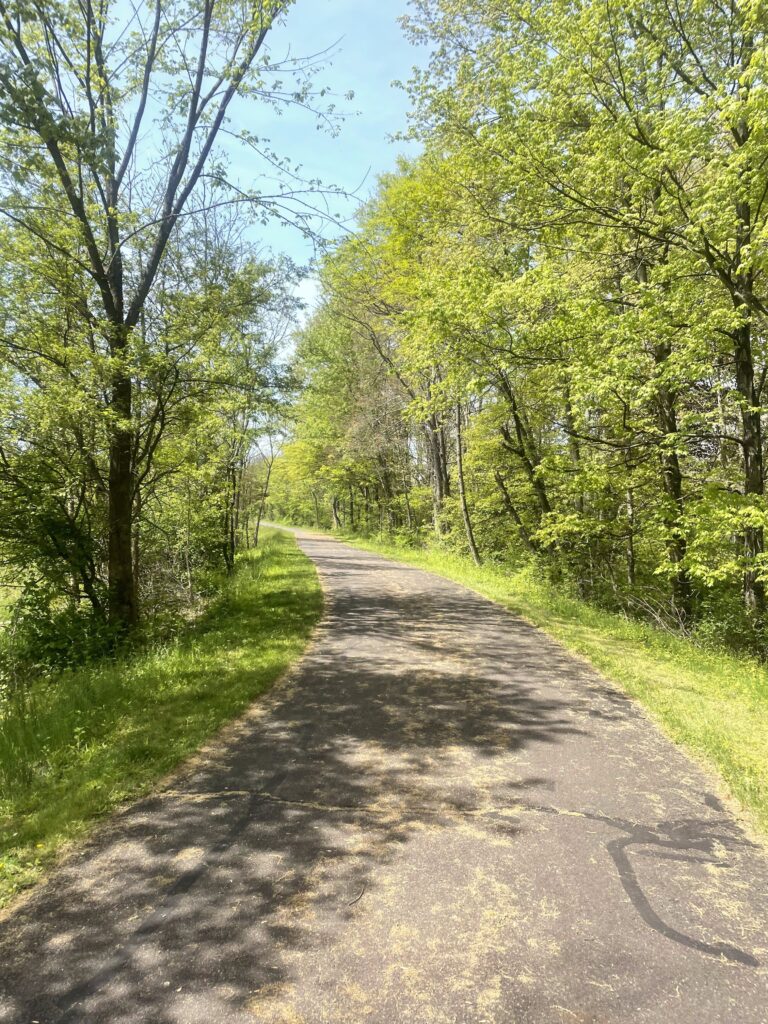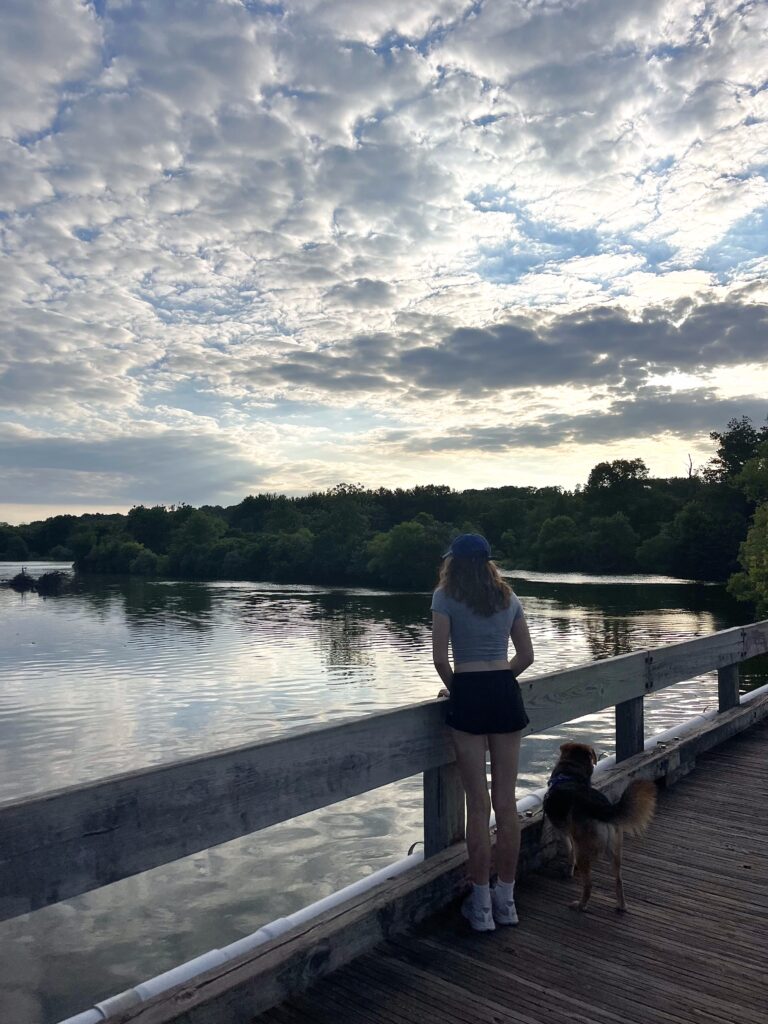By Sophia Birnbaum, UConn Journalism
July 2025

The fresh air of my hometown park has a way of cooling my nerves, even in the heat of summer. Walking along six miles of clearly paved trails as my dog, Eli, trots ahead of me, the stress of school and home life begins to melt away into the serene setting of nature around us.
Eli frequently stops to smell a patch of grass or to scan the forest for an animal that has been rustling in the bushes. Instead of tugging on his leash to urge him to continue our walk, I pause for a moment to relax and reflect. As I stand still, I find it easier to narrow my senses in on the soft brush of wind across my cheek, the sweet earthy smell of the air right before rain, the melodic chirping of robins resting in the branches above my head.
It is often easy to forget that this natural world exists around me, amidst the noise and chaos of our modern world. But in these moments, as I reconnect with nature, I am grateful to have the chance to experience the effortless beauty of the land around me.
Here along the winding paths of Peace Valley Park is where I find myself several times a week whenever I’m back in my home state of Pennsylvania on my breaks from school. I rely on this park, with its lush forests and glistening waters of Lake Galena, as my main connection to nature, a source of exercise and a way to clear my mind when life gets hectic.
But as the Trump Administration continues to make deep cuts to federal programs that support parks like this one, I have begun to wonder if my time in this beloved park is coming to an end. What will I do if my main connection to nature is severed?
The Trump Administration has fired over 1,000 National Parks employees in its first months and frozen billions of dollars in federal funds that support these parks. On May 2, Trump released a budget proposal that would slash the budget for national parks, historical sites, seashores and trails by almost 25%. That’s equivalent to over $1.2 billion from the National Parks Service’s budget. While these cuts may seem to exclusively affect bigger national parks, they also threaten the existence of smaller local parks like Peace Valley.

The Trust for Public Land is a nonprofit organization that works with communities across the United States to increase the access people have to public spaces and parks. The organization works primarily with local parks, but the TPL fears national budget cuts will catastrophically affect their efforts to better connect humans with nature.
More than 100 TPL parks projects are now in a state of “limbo”, stalled by cuts to federal funding, said the TPL’s CEO, Carrie Hauser, in an interview with PBS. These cuts come despite public support for increasing access to public spaces across political parties, Hauser said, citing extensive polling.
One of TPL’s main projects is its 10-Minute Walk program. This is a national initiative to address the disparities in access to public parks for low- to middle-income communities. The initiative’s goal is to ensure that no American is more than a ten-minute walk from a park.
The TPL released a funding proposal for the implementation of the 10-Minute Walk Program in my home state. They call the plan essential in the effort to “Preserve Pennsylvania.” It outlines the financial sources for limiting disparities across communities in their access to public spaces. While the plan acknowledges funding from state and local sources, it is also dependent on federal funding from a variety of departments ranging from the US Forest Service to the National Endowment for the Arts.
Peace Valley Park is run by the Bucks County Park Services located in the southeast corner of Pennsylvania that I call home. There are multiple overlaps in the funding for the county’s Parks and Recreation services and the TPL’s Preserve Pennsylvania Plan. Cuts made to the US Department of Housing and Urban Development are sparking particular concern over how federal funding losses can destroy the operations of local parks.
HUD administers Community Development Block Programs that provide essential financial support for community projects such as public parks. The Trump Administration plans to cut 84% of the department’s staff that oversees these programs, according to documents obtained by NPR.
The Office of Planning and Development is set to be among the agency’s cut programs, which will greatly hinder the department’s ability to process grants, said HUD employees interviewed by NPR. Not only will this affect my county’s ability to continue the upkeep of Peace Valley Park, but it will also further limit the access lower income community members have to public spaces.
I rely so heavily on my local park for the betterment of my physical and mental well-being, but I am not oblivious to those who have less access than I to public spaces, and therefore a greater reliance on their positive impacts.
The benefits myself and many others have experienced from easy access to public parks are plentiful. They are also alarmingly vulnerable to federal budget cuts.

Increased access to parks has been proven to better physical health by lowering stress, reducing heart rates and increasing physical activity. Time spent in parks has been linked to increased cognitive function and even presented as a viable prevention strategy for dementia-related diseases, like Alzheimer’s. The presence of parks in communities has even been associated with a reduction in violent crime, according to the University of Virginia Public Health System.
My access to Peace Valley Park has had a multitude of positive effects on my mental and physical wellbeing. Without access to this park, I’d exercise significantly less and would lose the already limited opportunities I have to experience nature. For members of underserved communities that have insufficient access to parks and outdoor spaces, these losses will be significantly amplified.
Still, there is hope for funding to be restored to these projects through increased state and local sources and philanthropic efforts, Hauser told PBS. It is also likely the loss of public spaces will anger American citizens across party lines, given that public polling has indicated bipartisan support of access to local parks, added Hauser.
While the thought of losing the park I cherish so much is a gut-wrenching reality I may have to face, there are others who will suffer from this loss even more than I will. Parks have the power to connect people with nature in a way that is becoming increasingly rare in our heavily industrialized society. The major cuts we are currently seeing on a federal level to projects aimed at improving access to local parks and their many benefits will only further the devastating divorce from nature our society is experiencing.
